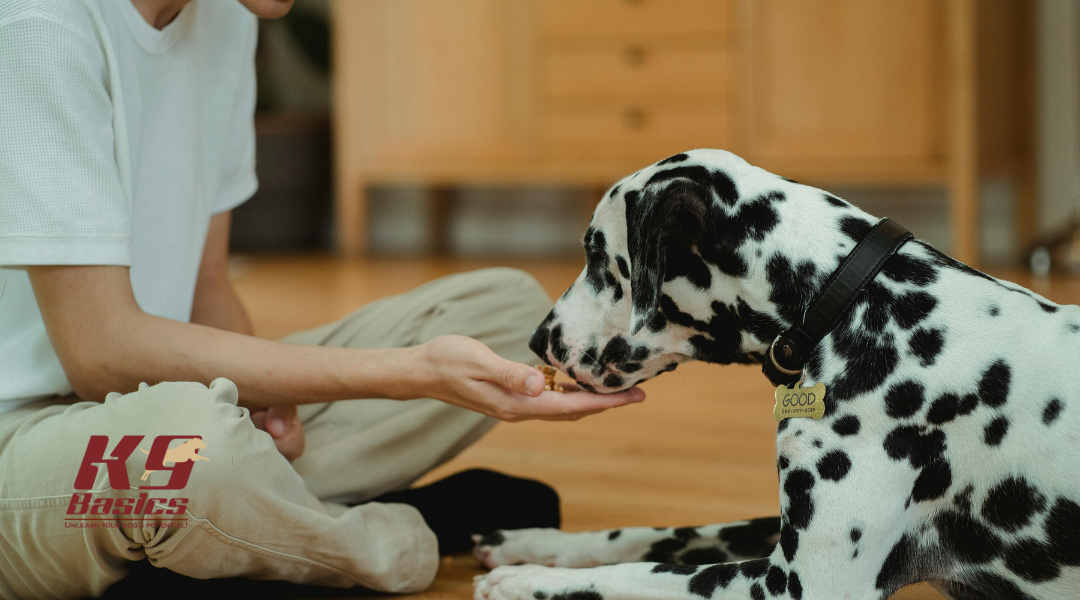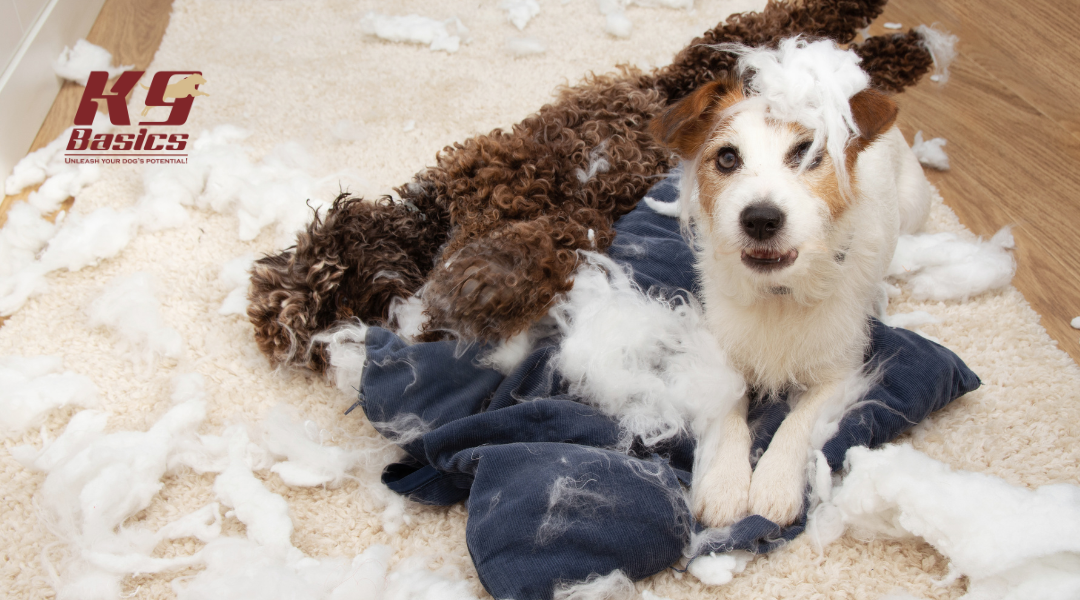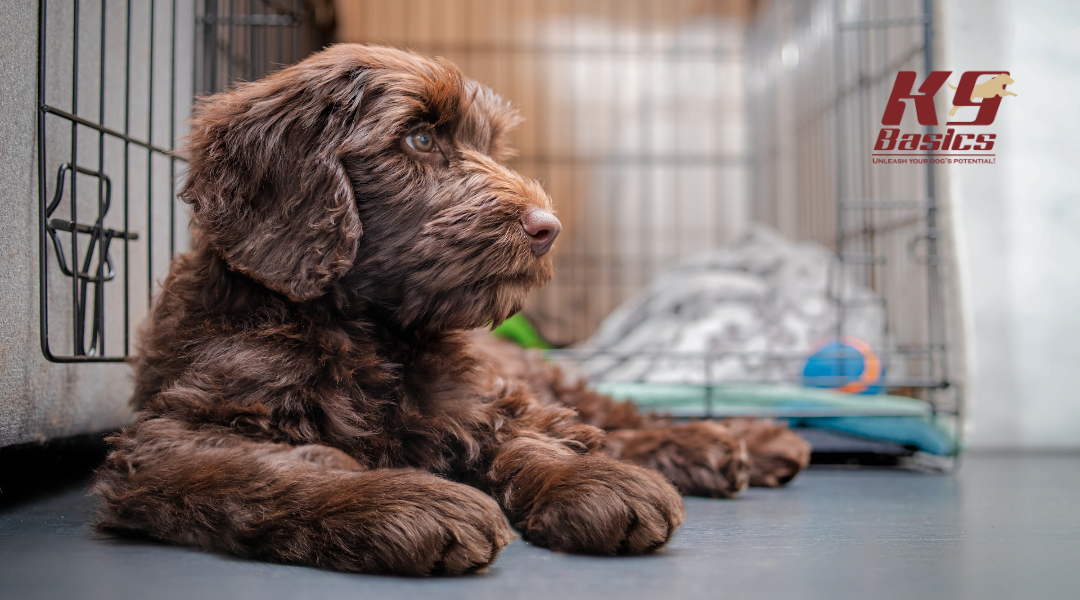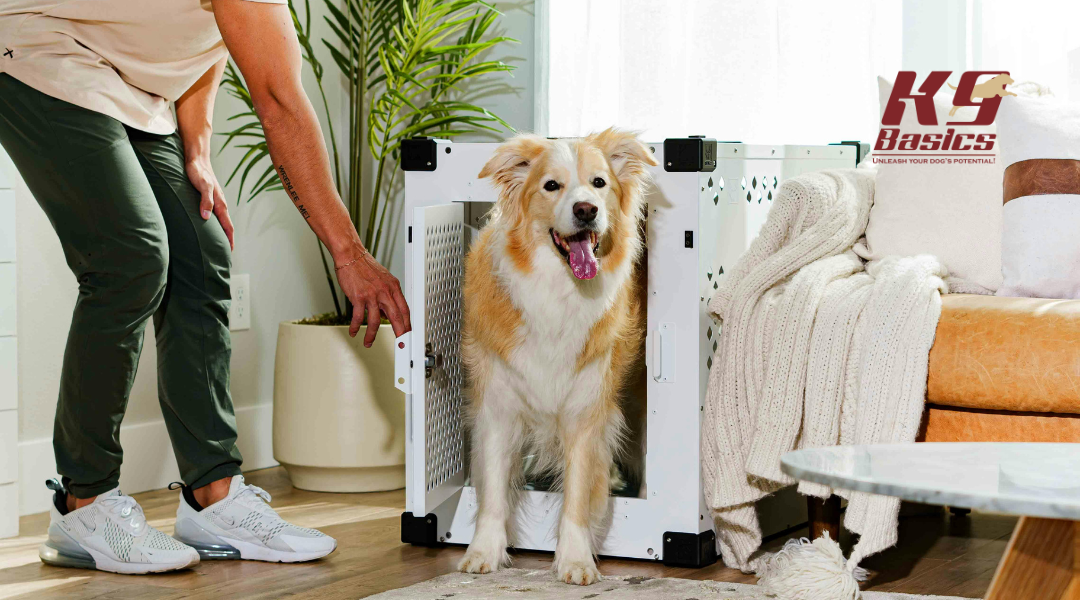Crate training is one of the most valuable skills you can teach your dog. Whether you’re welcoming a brand-new puppy, working with an older dog, or helping a rescue overcome past experiences, the way you introduce and use the crate makes all the difference.
When done correctly, the crate becomes more than just a box with four walls; it’s a safe haven, a quiet space, and a tool that supports healthy routines.
At K9 Basics, we’ve guided countless dogs and their owners through the ups and downs of crate training. No matter your dog’s age or history, crate training success is possible!
What is the Purpose of Crate Training?
At its core, crate training taps into a dog’s natural instincts. In the wild, canines seek out small, enclosed spaces, like dens, that provide protection, comfort, and a sense of security.
A crate recreates this environment in the home, offering your dog a private “den” where they can relax, rest, and feel safe.
The purpose of crate training goes far beyond convenience for owners. It’s a way to establish healthy routines that benefit both you and your dog. For puppies, crates accelerate house training by teaching bladder control and reinforcing the idea that “home” should stay clean.
For adult or senior dogs, the crate remains just as useful, helping with transitions, offering a quiet retreat during stressful situations, and creating consistency in daily life.
Another key benefit is safety. Crates prevent young puppies from exploring unsupervised and getting into dangerous situations, while also making car rides and travel more secure. And for dogs prone to separation anxiety, the crate, when paired with patience and positive reinforcement, helps reshape the experience of being alone into something calm and manageable.
Ultimately, the purpose of crate training is about balance: giving your dog freedom in the right moments and structure when they need it most.
Done right, it fosters trust, reduces anxiety, and creates a lifelong habit of self-soothing and relaxation.

Building Positive Associations From the Start
The key to successful crate training is making the crate a place your dog wants to be. Instead of seeing it as confinement, your pup should recognize the crate as their safe haven. Building positive associations early prevents resistance later and sets the stage for long-term success.
-
Creating the Right Routine Early On
Dogs thrive on routine, and the crate should become part of your dog’s daily rhythm. Just as you’d put a baby down for naps after feeding and playtime, aim to place your puppy in the crate after meals, walks, or bathroom breaks. This creates a predictable cycle: eat, exercise, rest. Position the crate in a room where you spend time so your dog doesn’t feel isolated—they should be able to rest while still seeing you nearby.
-
Using Feeding Times to Reinforce the Crate
Feeding your dog inside the crate teaches them that good things happen there. Start by placing their bowl near the entrance, and as they grow comfortable, move it further inside. Over time, mealtime becomes a rewarding routine tied directly to the crate. This technique works especially well for dogs with past negative associations, helping to “re-wire” their expectations.
-
High-Value Rewards: Toys, Treats, and Puzzles
Beyond meals, fill the crate with items your dog genuinely enjoys. A favorite chew toy, a stuffed Kong, or a puzzle feeder not only makes the crate inviting but also engages your dog’s mind, turning crate time into enrichment time. For puppies, this helps burn off mental energy; for older dogs, it provides comfort and entertainment. Always reward calm behavior in the crate—tossing treats inside or offering praise—so your dog learns that choosing to relax in their den earns them something positive

3 Common Crate Training Hurdles
Crate training isn’t always a straight line to success. Every dog comes with their own history, temperament, and comfort levels, which means some resistance is natural. Here are three of the most common hurdles dog owners face—and how to overcome them.
1. When Puppies Resist: Avoiding Separation Anxiety
Young puppies often protest the crate because it feels like a sudden separation from their “pack.” Whining, barking, or scratching at the door is their way of communicating discomfort. The key is to create positive associations while also building independence. Start with short crate sessions when you’re still in the room, then gradually extend the time and distance.
Pair crate time with a puzzle toy or chew after a walk, so your puppy is both tired and happily occupied. Most importantly, avoid letting them out while they’re whining, otherwise, you risk reinforcing the behavior.
2. Negative Past Experiences: Reassociating the Crate
Rescue dogs or older dogs may have learned to fear crates due to mishandling or stressful experiences in the past. In these cases, reassociating the crate takes patience. Introduce it slowly, keeping the door open at first, and reward even small steps toward engagement—like sniffing or stepping inside. Feeding meals in or near the crate can reframe it as a positive place, while using favorite toys or high-value treats helps rebuild trust. Sometimes, changing the style of the crate (e.g., covered vs. uncovered, wire vs. plastic) can make a world of difference.
3. Travel and Imported Dogs: Adjusting to Different Crate Styles
Dogs that have been flown commercially or spent time in transport crates may develop a negative association with confinement. To help them adjust, focus on making the crate feel different from their past experience—softer bedding, a cover for added coziness, or switching crate designs entirely. Introduce the crate as part of everyday life, not just for travel. By turning it into a predictable, relaxing routine at home with plenty of praise and positive reinforcement, you can transform their view of the crate from a stressful memory into a safe retreat.

Step-by-Step Solutions for Reassociating the Crate
For dogs who struggle with the crate—whether due to fear, past trauma, or simple resistance—patience and structure are essential. The process of reassociation requires breaking down negative emotions and replacing them with positive, reliable experiences. Here’s a step-by-step guide to help rebuild your dog’s relationship with their crate.
1. Breaking Down Fear and Rebuilding Trust
Start by removing all pressure. Keep the crate door open and allow your dog to explore at their own pace. Reward any interaction, even if it’s just sniffing near the entrance. Gradually, encourage them to step inside by tossing treats or placing a favorite toy just beyond the doorway. Over time, small successes build trust and reduce fear.
2. Covered vs. Uncovered Crates: Finding the Right Fit
Some dogs feel safer in a covered crate that mimics a den, while others prefer the visibility of an uncovered wire crate. Experiment with both options to see which helps your dog feel calmer. If a dog associates one style with past stress (such as airline travel crates), switching to a different design can provide a fresh start.
3. Exhaustion + Calm = Success: Timing Crate Sessions after Exercise
Exercise is your ally when crate training. After a walk, play session, or training activity, your dog will naturally be more relaxed. Place them in the crate during this calm state, paired with a chew or puzzle toy. Over time, your dog will begin to link crate time with rest and recovery, not stress.
4. Establishing Crate Training Routines That Stick
Dogs thrive on predictability. Introduce crate sessions as part of daily life—not just when you leave the house. Use short periods during the day for downtime, so the crate becomes a normal, neutral space rather than a cue for separation.
Bedtime Rituals: Crate as the Safe Sleeping Space
At night, make the crate part of your dog’s sleep routine. Place it in your bedroom or nearby so your dog feels connected but secure. Over time, the crate will represent nighttime rest, much like a child’s bed signals sleep.
Quiet Time Practice: Crates as Rest, Not Isolation
The crate should always be framed as a quiet, safe space, never punishment. Encourage your dog to relax in the crate while you’re still in the room, perhaps while you watch TV or work. This teaches them the crate is a place for calm observation and rest, not loneliness.
Consistency is Key: Daily Repetition Builds Comfort
Repetition cements the habit. Use the crate daily, always pairing it with positive experiences like meals, toys, or naps. The more consistent you are, the quicker your dog learns to view the crate as part of life’s routine rather than an unpredictable event.
Advanced Tips for Smooth Crate Training
One of the biggest challenges owners face is whining or barking in the crate. It’s natural for dogs to vocalize when they want attention, but letting them out too soon reinforces the behavior. Instead, wait for a moment of calm before opening the door. This teaches your dog that quiet, relaxed behavior, not whining, earns freedom.
Another key to advanced success is finding the right balance between freedom and structure. Too much freedom too soon can cause setbacks, while overuse of the crate may lead to frustration.
Think of the crate as one part of your dog’s overall lifestyle: use it to create calm downtime, but also provide plenty of exercise, play, and engagement outside the crate. This balance ensures your dog feels fulfilled, not restricted.

Frequently Asked Questions
How Long Can My Dog Stay in the Crate?
The answer depends on age and energy level. Puppies under six months should generally not be left in a crate for more than 3–4 hours at a time, since their bladders are still developing. Adult dogs can often handle longer stretches, up to 6–8 hours if necessary, but it’s always best to provide breaks for exercise, water, and mental stimulation. Remember, the crate is meant to be a safe resting place, not a substitute for play, walks, or interaction.
Should I Cover the Crate at Night?
Covering a crate can help some dogs feel more secure by creating a den-like environment that blocks out distractions. For others, especially those who like to keep an eye on their surroundings, an uncovered crate may feel less confining. Try both approaches and watch your dog’s behavior: if they settle more easily with the crate covered, it’s likely the right choice. Always ensure proper airflow and never cover the crate completely in hot weather.
What If My Dog Still Hates the Crate?
If your dog consistently resists, it’s important to go back to basics. Don’t force them inside; instead, focus on reassociating the crate with positive experiences. Feed meals nearby or inside the crate, toss high-value treats just beyond the door, and allow your dog to enter and exit freely at first.
You may also experiment with different crate styles. Some dogs prefer the open feel of wire crates, while others relax more in covered plastic models. If progress is still slow, consider working with a professional K9 Basics trainer who can provide tailored strategies for your dog’s unique needs.
Make Crate Training a Success, Let K9 Basics Help!
Call us at (866) 592-2742 or, if you’re from New Jersey, Pennsylvania, Delaware, or New York, visit us at 131 Kenilworth Road, Marlton, NJ 08053, to learn more about our group training classes.
Also, browse our blog and social media for various topics about dogs and their lives with us!
